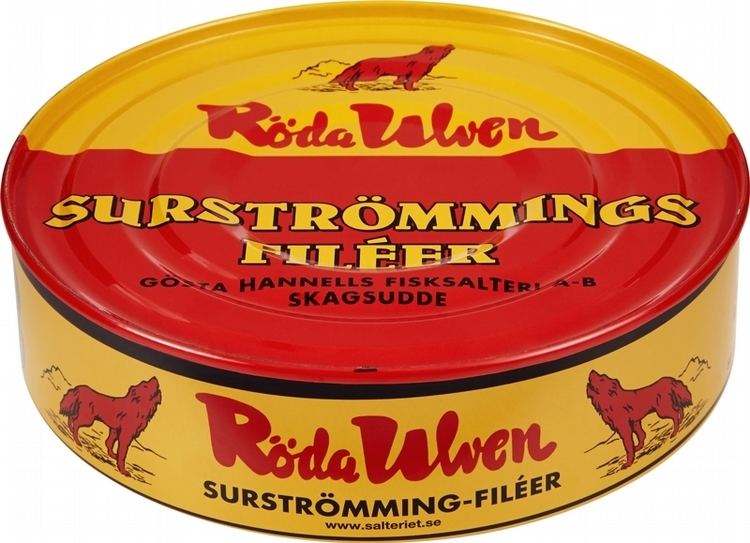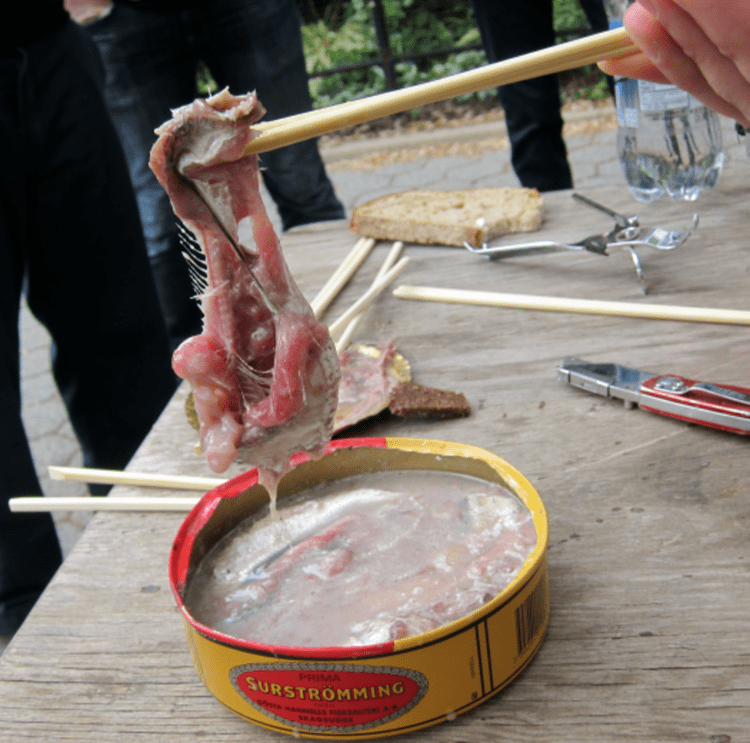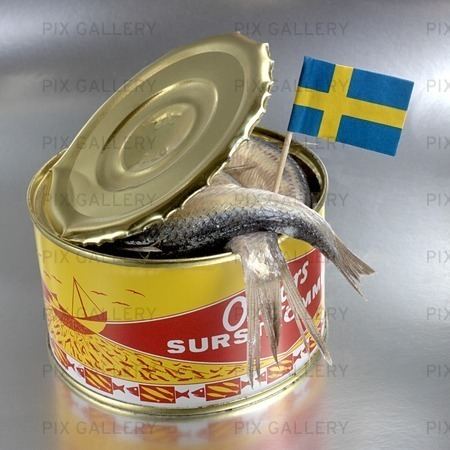 | ||
Similar | ||
The worst food ever surstr mming
Surströmming ([²sʉːˌʂʈrœmːɪŋ], Swedish for "sour herring") is fermented Baltic Sea herring that has been a part of traditional northern Swedish cuisine since at least the 16th century.
Contents
- The worst food ever surstr mming
- Americans try surstr mming the smelliest food in the world
- Origin
- Chemical process
- Production
- Eating surstrmming
- Museum
- Controversy
- Food administration rules
- Airline bans
- German eviction
- References

Just enough salt is used to prevent the raw fish from rotting (chemical decomposition). A fermentation process of at least six months gives the lightly-salted fish a characteristic strong smell and somewhat acidic taste.

When a can of surströmming is opened, the contents release a strong and sometimes overwhelming odor. The dish is ordinarily eaten outdoors. According to a Japanese study, a newly opened can of surströmming has one of the most putrid food smells in the world, even more so than similarly fermented fish dishes such as the Korean hongeohoe or Japanese kusaya.

The Baltic herring, known as strömming in Swedish, is smaller than the Atlantic herring, found in the North Sea. Traditionally, the definition of strömming is "herring fished in the brackish waters of the Baltic north of the Kalmar Strait". The herring used for surströmming are caught just prior to spawning.

At the end of the 1940s, producers lobbied for a royal ordinance (Swedish: förordning) that would prevent incompletely fermented fish from being sold. The decree forbade sales of the current year's production in Sweden prior to the third Thursday in August. While the ordinance is no longer on the books, the retailers still maintain the date for the "premiere".

Americans try surstr mming the smelliest food in the world
Origin
Fermented fish is an old staple in European cuisines. The oldest archeological findings of fish fermentation are 9200 years old and from the south of today's Sweden. More recent examples include garum, a fermented fish sauce made by the ancient Greeks and Romans, and Worcestershire sauce, which also has a fermented fish ingredient.
This method of preservation may have developed when brining was still expensive due to the cost of salt. The fish are initially marinated in a strong brine solution that draws out the blood, and then fermented in a weaker brine in barrels prior to canning.
The canning procedure, introduced in the 19th century, enabled the product to be marketed in shops and stored at home, whereas at one time the final stage would have been storage in large wooden barrels and smaller, one-litre kegs. Canning also enabled the product to be marketed farther south in Sweden.
Chemical process
The fermentation starts from a lactic acid enzyme in the spine of the fish, and so the fermentation is by autolysis; together with bacteria, pungent smelling acids are formed in the fish such as propionic acid, butyric acid and acetic acid. Hydrogen sulfide is also produced. The salt raises the osmotic pressure of the brine above the zone where bacteria responsible for rotting (decomposition of proteins) can thrive and prevents decomposition of fish proteins into oligopeptides and amino acids. Instead the osmotic conditions enable Haloanaerobium bacteria to prosper and decompose the fish glycogen into organic acids, making it sour (acidic).
Production
The herring are caught in April and May, when they are in prime condition and just about to spawn. Prior to spawning, the herring have not fattened. They are then put into a strong brine for about 20 hours which draws out the blood, the heads are removed and they are gutted and put into a weaker brine solution. The barrels are then placed in a temperature controlled room kept at 15–20 °C (59–68 °F). Canning takes place at the beginning of July and for five weeks thereafter. Ten days prior to the premiere the final product is distributed to wholesalers. The fermentation of the fish depends on a lactic acid enzyme in the spine that is activated if the conditions are right (temperature and brine concentration). The low temperature in Northern Sweden is one of the parameters that affects the character of the final product.
Fermentation continues in the can which causes the can to bulge noticeably. Prior to modern canning methods, surströmming was sold in wooden barrels, and was only consumed locally. As even the smallest one litre kegs could leak, surströmming was bought directly from the producers in small quantities for immediate consumption.
Half a year to a year later gases have built up sufficiently for the once flat tops of the cylindrical tins to bulge into a more rounded shape. These unusual containers of surströmming can be found today in supermarkets all over Sweden. However, certain airlines have banned the tins on their flights, considering the pressurised containers to be potentially dangerous (see also below). Species of Haloanaerobium bacteria are responsible for the in-can ripening. These bacteria produce carbon dioxide and a number of compounds that account for the unique odour: pungent (propionic acid), rotten-egg (hydrogen sulfide), rancid-butter (butyric acid), and vinegary (acetic acid).
Eating surströmming
Surströmming is often eaten with a kind of bread known as tunnbröd ("thin bread"). This thin, either soft or crispy bread (not to be confused with crispbread) comes in big square sheets when soft or as rounds of almost a metre in diameter when crisp.
The custom in The High Coast (Höga Kusten), the area of northern Sweden where this tradition originates, is to make a sandwich, commonly known as a "surströmmingsklämma", using two pieces of the hard and crispy kind of tunnbröd with butter, boiled and sliced or mashed potatoes (often mandelpotatis or almond potatoes) topped with fillets of the fish together with finely diced onions. It is also eaten on the plate with the above ingredients. To balance the strong flavour of the fish, Västerbotten cheese is sometimes eaten with it.
In the southern part of Sweden, it is customary to use a variety of condiments such as diced onion, gräddfil (fat fermented milk/sour cream similar to smetana) or crème fraîche, chives and sometimes even tomato and chopped dill.
The surströmming sandwich is usually served with snaps and light beers like pilsner or lager. Other drinks of choice are svagdricka (lit. "weak drink", a Swedish low alcohol dark malt beverage brewed since the Middle Ages, a small beer slightly similar to porter), water or cold milk. However, exactly what to drink or not to drink to surströmming is highly disputed among connoisseurs. Some claim that cold milk is the right and only choice while others refer to svagdricka as the most traditional drink. Surströmming is usually served as the focus of a traditional festivity, a "surströmmingsskiva" (surströmming party).
Many people do not care for surströmming, and it is generally considered to be an acquired taste. It is a food which is subject to strong passions, as is lutefisk.
Museum
On June 4, 2005, the first surströmming museum in the world was opened in Skeppsmalen, 30 km (19 mi) north of Örnsköldsvik, a town at the northern end of the High Coast. The name of the museum is "Fiskevistet" (translated to The Fish Visit).
Controversy
German food critic and author Wolfgang Fassbender wrote that "the biggest challenge when eating surströmming is to vomit only after the first bite, as opposed to before".
Food administration rules
Surströmming today contains higher levels of dioxins and PCBs than the permitted levels for fish in the EU; Sweden was granted exceptions to these rules from 2002 to 2011, and a renewal of the exceptions was then applied for. Producers have said that if the application is denied they will only be allowed to use herring less than 17 centimeters long, which contain lower levels, which will affect the availability of herring.
Airline bans
In April 2006, several major airlines (such as Air France and British Airways) banned the fish, claiming that the pressurised cans of fish are potentially explosive. The sale of the fish was subsequently discontinued in Stockholm's international airport. Those who produce the fish have called the airlines' decision "culturally illiterate", claiming that it is a "myth that the tinned fish can explode".
German eviction
In 1981, a German landlord evicted a tenant without notice after the tenant spread surströmming brine in the apartment building's stairwell. When the landlord was taken to court, the court ruled that the termination was justified when the landlord's party demonstrated their case by opening a can inside the courtroom. The court concluded that it "had convinced itself that the disgusting smell of the fish brine far exceeded the degree that fellow-tenants in the building could be expected to tolerate".
